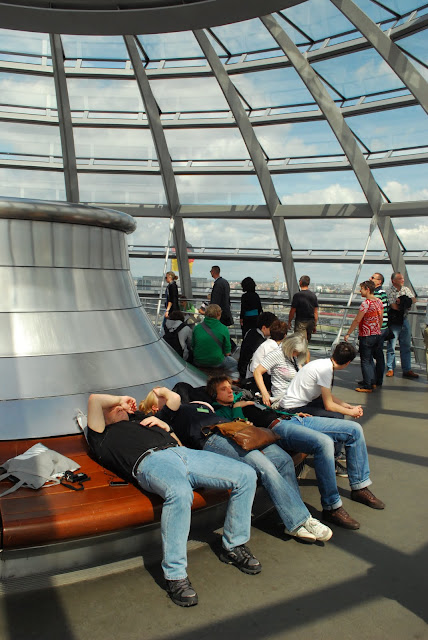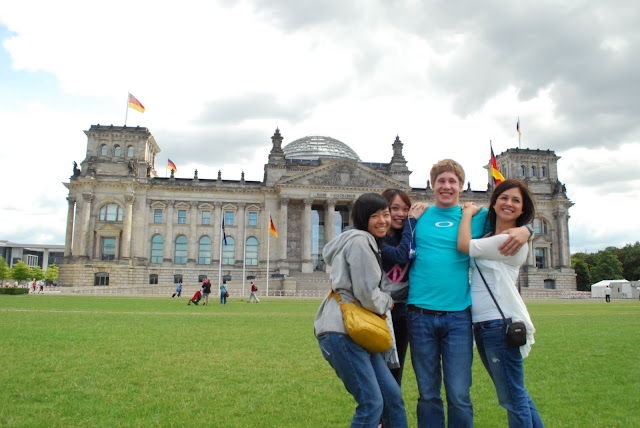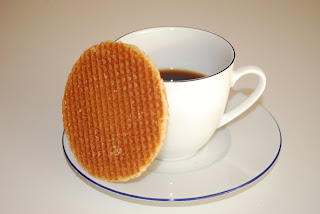Saturday, 2 July 2011
Not having a pressing appointment this morning, we slept in a little later and were able to eat an unhurried breakfast in the hotel restaurant. The forecast on the lobby bulletin board called for rain today, so we all found raincoats and umbrellas. Then, we all walked back to the Alexanderplatz station together. Clo purchased a new umbrella at the station, but it broke clean in half the first time she opened it. The store gave her another one, and we gave her a wide berth lest this one break as well.
We rode the subway to Gesundbrunnen station where we were to take a tour of an abandoned WWII civilian bomb shelter beneath the station (http://berliner-unterwelten.de/tour-1.13.1.html). In an effort to protect the population of Berlin during the Allied air raids, the Third Reich had constructed numerous fortifications around the city. Most, like this one, were really just for show, the walls being too thin to survive a direct hit. However, they were relatively gas-proof; Germans remembered how wide-spread the use of gas had been during the First World War.
The bunker system was pretty elaborate, extending across several levels. In case of power outages, the walls had been coated with a phosphorescent paint. Even after all these years, one could still see by the walls’ dim green glow. The guide said he sometimes came down at night to try and navigate in the dark.
Defense systems like this one are still being discovered and excavated all over the city, especially in the eastern sector where the Soviets had not been as thorough with their cleanup. Still today, unexploded munitions from the war are occasionally unearthed and need to be disarmed. Every year or so, a few people are killed by accidental explosions.
Our tour guide was Swedish (or maybe Danish) which allowed for an interesting perspective on events. He was rather frank about how terrible the “Germans” (i.e. Nazis) had been. *He also said no pictures were allowed during the tour because tourists might post images of Nazi symbols online and bring the wrong kind of publicity to this place.* I wasn’t sure how our German friends from Duisburg felt about the commentary and later comments about the Holocaust, but they seemed to be just as horrified as we were that people could do such terrible things to one another.
After the underground tour, we headed towards the city center.We stopped by the Berliner Dom, the city cathedral where climbed the stairs to the top of the dome. Afterwards, we walked down Unter den Linden, looking at the impressive buildings. We passed one of the city’s opera houses, the famous Humboldt University, a memorial to the victims of the Nazi dictatorship, and other sites. It was raining pretty heavily at this point, so we decided to take a short break before continuing further.
 |
| Clo on the roof of the Berliner Dom. |
 |
| Gallery view of the interior of the Berliner Dom. |
 |
| Berliner Dom altar. |
 |
| Interior of the Neue Wache containing the Memorial to the Victims of War and Tyranny |
We stopped for pictures and a short snack break at the Brandenburg Gate, the last surviving city gate and a symbol for the city during the Cold War.
Afterwards, we proceeded south along the former boundary of the Berlin Wall towards Potsdamer Platz. We passed the American embassy (recently renovated) and paused for a few minutes at the Memorial for the Murdered Jews of Europe. The Memorial appears to be built on a hill with regularly-spaced, rectangular stone markers giving the appearance of Jewish grave markers. However, the memorial is actually built in a depression which creates an optical illusion. The central stones, which seem to rise slightly above the others as though on a low hill, are actually several meters taller. Walking amongst the rows, the grey stones appeared almost black in the dim light and towered overhead like some primeval forest. The rain made everything damp and heavy, and it wasn’t long before I felt that I should leave.
 |
| Arial view of the Memorial to the Murdered Jews of Europe. (Source: de:Benutzer:Schreibkraft) |
Further along the street was Potsdamer Platz, a major pre-war cultural and transportation hub which was divided by the Berlin Wall and has now been revitalized. Among other things, Daimler and Deutsche Bahn have major centers here and Sony has constructed a large pavilion with shops, museums, and a theater.
 |
| Potsdamer Platz in the rain. |
We looked around the square before heading off the Gendarmenmarkt, a square with a long-running French influence. In an effort to attract foreign labor, displaced French Protestant Huguenots were allowed to settle in Berlin around 1700. Their congregation built a church on the square which was later given a dome to match the nearby Deutscher Dom and complete the appearance of the square. We toured a nearby upscale shopping mall which included a branch of the Parisian department store Galleries Lafayette. While we looked around, Prof. Chamoni ate ice cream in the mall’s café. For a laugh, I wanted to ask the café’s jazz pianist if he knew “As Time Goes By”, but he didn’t seem to be taking requests.
We returned to the hotel to change before dinner. Most of the group wanted to return to Hackescher Markt for dinner, but I was feeling sick again and opted to avoid the rain by ordering from an Indian delivery service. I found a good restaurant online and placed an order. Around this time Kylace came down to the lobby, and not wanting to go out, asked me to order her dinner too. Unfortunately, neither of us told Kylace’s roommate Ivy about our order, so when the food was delivered an hour later, she assumed the deliveryman had made a mistake and sent him away! Once we realized what had happened, we reordered the food and explained the situation, but no one ever showed up. After waiting nearly a total of three hours, we gave up and bought sandwiches from a gas station next door before going to bed.
































